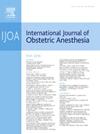Intravenous dexmedetomidine use in obstetric anesthesia: a focused review
IF 2.6
3区 医学
Q2 ANESTHESIOLOGY
引用次数: 0
Abstract
Dexmedetomidine is an alpha-2 adrenergic receptor agonist with analgesic properties. Dexmedetomidine is currently U.S. Food and Drug Administration (FDA) approved for intravenous (IV) administration in non-pregnant patients. However, it has shown promise for various off-label indications in obstetric anesthesia. This review focuses on reported uses for IV dexmedetomidine in obstetric anesthesia. Intravenous dexmedetomidine has reported efficacy for producing light sedation, analgesia, and anxiolysis in the parturient. In addition, the use of IV dexmedetomidine during cesarean delivery has been reported to alleviate symptoms of postpartum depression and reduce the incidence of shivering and postoperative nausea and vomiting. In the setting of trauma, IV dexmedetomidine may reduce the risk of post-traumatic stress disorder. Further understanding of IV dexmedetomidine’s benefits and the recent advances in its clinical use allows clinicians to leverage its versatility to improve patient outcomes.
求助全文
约1分钟内获得全文
求助全文
来源期刊
CiteScore
4.70
自引率
7.10%
发文量
285
审稿时长
58 days
期刊介绍:
The International Journal of Obstetric Anesthesia is the only journal publishing original articles devoted exclusively to obstetric anesthesia and bringing together all three of its principal components; anesthesia care for operative delivery and the perioperative period, pain relief in labour and care of the critically ill obstetric patient.
• Original research (both clinical and laboratory), short reports and case reports will be considered.
• The journal also publishes invited review articles and debates on topical and controversial subjects in the area of obstetric anesthesia.
• Articles on related topics such as perinatal physiology and pharmacology and all subjects of importance to obstetric anaesthetists/anesthesiologists are also welcome.
The journal is peer-reviewed by international experts. Scholarship is stressed to include the focus on discovery, application of knowledge across fields, and informing the medical community. Through the peer-review process, we hope to attest to the quality of scholarships and guide the Journal to extend and transform knowledge in this important and expanding area.

 求助内容:
求助内容: 应助结果提醒方式:
应助结果提醒方式:


